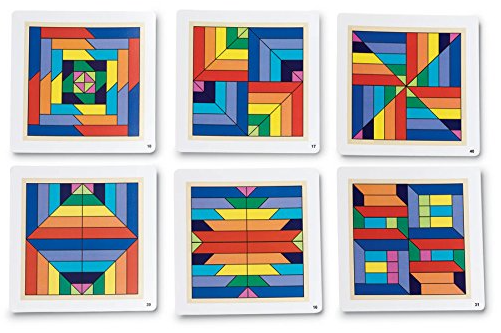 |
| Pattern Play - Color by Design |
With 40 blocks and 40 pattern cards, Pattern Play is a great activity for working on spatial orientation. The pattern cards are numbered and increase in difficulty, from easy to complex. Each pattern will use all the blocks.
The pattern blocks are wood, brightly colored, and have been easy to manipulate for most. There is a very nice wooden tray to build in. Would highly recommend.
If you are interested in more of this type of activity, check out my post on What's in Your Therapy Box? Pattern Blocks Edition.
Check out the other Pattern Play products:
Try this:
- Lay the pieces for the pattern card in different orientations on the table top so the person has to pick each one up and turn it to find the correct fit.
- Place a piece for the individual if he gets stuck. They remove it, turn it into a different orientation and give it back to the individual to place.
- Divide the card into quarters and show only 1 quarter at a time by placing a piece of paper over the other 3/4.
- Catch mistakes as they happen as they will impact everything that happens next. I give a vague comment such as "Are you sure" or "Check again" and let the individual figure out what he did wrong and correct it on his own if he can.
- Keep the encouragement going as the puzzle gets more difficult, especially if the individual is prone to frustration.
- Give the individual one piece at a time if he cannot plan how to build the structure.
- Use consistent language while building when working on spatial orientation, such as rotate, flip, turn, above, right, left, under, etc.
- Work on visual discrimination, visual closure, spatial relations, eye-hand coordination, visual form constancy, figure ground, manual dexterity, coordinated use of both hands, executive functioning skills, process skills, play and leisure exploration and participation
In the box: 40 blocks, 40 pattern cards
If you are interested in purchasing this game or just want more information, click on the image below.
If you are interested in purchasing this game or just want more information, click on the image below.




No comments:
Post a Comment
Thank you for taking the time to comment.